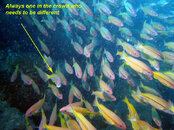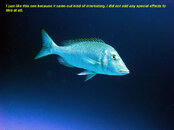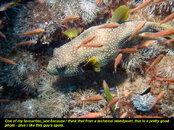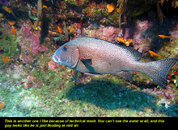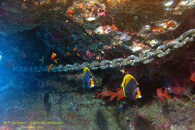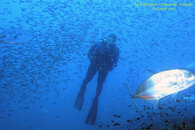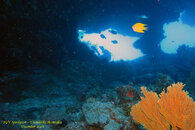NudeDiver
Contributor
As you may guess, I have the #4100.5 TTL Digital Slave Sensor. I use it with the Canon G2, Ikelite housing, and DS-125. I have taken some great pictures with it - but I am confused by something. On Ike's website, it says:
I have found the best success with using the "opaque" shield thing for the housing to bounce the camera's flash up for this sensor to detect, putting the camera on the "P" setting (rather than auto), and setting the camera flash to always fire. This makes the strobe always fire. The strobe is set for "TTL" rather than full, half, or whatever. The sensitivity setting on the sensor is mid-way between min and max.
So - my question is - is there any better setting stuff I can use to make sure everything works as intended? I was re-reading the web page for the sensor, and it reads to me like it is intended for something other than what I am using it for. It sounds like it is really for setting off a SECOND strobe, rather than a single strobe fired by the camera. I also see that this unit has been discontinued. Any word on why?
Am I fighting a losing battle with this setup, or can you give me some advice on how to do it better?
Also - I just got my repaired strobe and new smart charger back from Ikelite, but they didn't include a manual for the new smart charger - so I have no idea what the blinking/solid little red light on the charger means. Can I get a manual?
Thanks!
nd
The G2 is a point and shoot. Further, this whole system was sold to me as something that works together - and, in fact, it does work. Most of the time.The TTL Slave Sensor is designed for use with Film and dSLR cameras. It is NOT reccommended for use with point and shoot digital cameras.
I have found the best success with using the "opaque" shield thing for the housing to bounce the camera's flash up for this sensor to detect, putting the camera on the "P" setting (rather than auto), and setting the camera flash to always fire. This makes the strobe always fire. The strobe is set for "TTL" rather than full, half, or whatever. The sensitivity setting on the sensor is mid-way between min and max.
So - my question is - is there any better setting stuff I can use to make sure everything works as intended? I was re-reading the web page for the sensor, and it reads to me like it is intended for something other than what I am using it for. It sounds like it is really for setting off a SECOND strobe, rather than a single strobe fired by the camera. I also see that this unit has been discontinued. Any word on why?
Am I fighting a losing battle with this setup, or can you give me some advice on how to do it better?
Also - I just got my repaired strobe and new smart charger back from Ikelite, but they didn't include a manual for the new smart charger - so I have no idea what the blinking/solid little red light on the charger means. Can I get a manual?
Thanks!
nd




